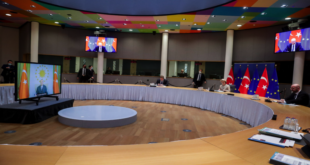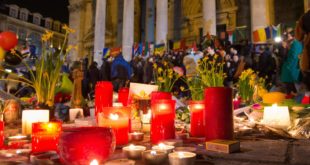An uncomfortable blame-game has followed revelations that three British school girls were able to successfully navigate their way to Turkey and on to Syria via Gatwick airport. British politicians, security officials and members of the public have demanded answers as to how Amira Abase (15), Shamima Begum (15) and Kadiza Sultana (16), all minors, were able topass unaccompanied through airport security at Gatwick and again upon landing in Istanbul as they travelled to join the self-proclaimed “Islamic State”.
David Cameron spoke of the need for airlines to do more to prevent radicalised British teenagers from travelling to join the extremist group, a sentiment echoed by Rushanara Ali, local MP for the girls’ constituency of Bethnal Green and Bow.Turkish Airlines has also come under fire for not picking up on three unaccompanied minors travelling the well-beaten track to the Islamic State, or reporting the incident to British police.
Also in the dock has been Scotland Yard, who are accused of failing to note the radicalisation risk to these girls, despite having previously questioned them about a friend who had travelled to Syria several months before. Symptomatic of this blame-game, the girls’ school – Bethnal Green Academy – has taken pains to demonstrate its own non-culpability in the girls’ radicalisation. Bleating government counter-radicalisation buzzwords by affirming its commitment to “promoting British values”, the school, like everyone else, has sought to prove its innocence.
This fixation with shallow questions of logistics and immediate culpability is symptomatic of a greater paralysis afflicting the UK government’s counter-radicalisation strategy. Reactionary policies directed at preventing the radicalised from travelling to Syria and Iraq without tackling the problem of radicalisation itself are short-sighted, if not out-right dangerous and counter-productive. Is it really any better to have a trapped, corralled and embittered radical community venting frustrations within our own society?
Ultimately, security measures alone are, at best, insufficient. What needs to be understood is why teenagers and young adults like Amira, Shamima and Kadiza feel alienated from their homes in the UK and what it is they hope to find and achieve in joining the Islamic State.
Radicalisation: a complex interaction of “push” and “pull” factors
The girls’ actions have provoked an emotional and polarised response from political figures and commentators. Some, like the Independent’s Sara Khan, have reacted with sympathy, arguing that Islamic State propagandists deliberately target and “groom” naïve youths. Others, such as the Telegraph’s Emma Barnett, claim that the girls joined the Islamic State’s “murderous cult of their own volition” and should know what is right and wrong. This sentiment has been echoed by Conservative MP Sarah Wollaston, who Tweeted: “Joining IS knowingly colludes with their grotesque mass murders, torture, enforced slavery & rape. No one can claim not to know.”
And so the debate rages on: are the girls joining the Islamic State really so naïve and misguided, or do they know exactly what they are getting themselves into? Both of these opposing views are highly simplistic, yet each nonetheless contains a grain of truth.
The case of Amira, Shamima and Kadiza is not unique. An estimated 50 British girls have so far joined the Islamic State, while it is believed that women and girls constitute roughly 10% of all those travelling to join the group from Europe, North America and Australia – most of them settling in the Islamic State’s de factocapital of al-Raqqa. While we cannot assume their motives to be uniform, a number of common trends and factors can be identified. These fit into two broad, mutually reinforcing categories: “push” factors which alienate individuals from their home societies in the west; and “pull” factors which exploit and amplify this alienation to attract people to the self-styled “Caliphate”.
Primary amongst the “push” factors is the identity and integration crisis experienced by many second-generation Muslim immigrants living in western cultures, to which the schoolgirls’ decision can be read as a response. As discussed in Carolina Tomio’s article for this website, children of immigrants from Muslim-majority countries face a difficult balancing act, pressured at once to integrate into British society while maintaining the Islamic and cultural identity of their “homeland”. The fact that for many it is a homeland they have never truly known makes this challenge even more difficult and unsettling.
The way second-generation immigrants respond to this challenge is often polarised between those who integrate with their parents’ host societies completely, and those who reject those societies outright. This second route can take various forms, with varying intensity. For many, rejection is expressed less as hostility than it is as reclusiveness. Adopting conservative Islamic dress and clinging to small circles of likeminded friends in order to preserve cultural-religious identity and avoid aspects of the host societies considered unsavoury or incompatible with an Islamic cultural-religious outlook are common ways in which this is manifested.
Regarding such issues around identity and integration, Javaria Akbar has written about the difficulties many Muslim women and girls, like herself, face in trying to make friends in western societies. “For me the only place where I feel like I belong is with my three Muslim sisters who are my best friends”, she writes. “I can talk to my sisters about arranged marriage without them thinking it’s archaic and oppressive. We’ll often chat about God, religion and prayer together, without worrying about being seen as madwomen.” This sense of not-belonging, or of being misunderstood by their host society, is an insecurity the Islamic State actively preys upon.
Alongside these general societal factors, specific state policies contribute to “pushing” second-generation Muslims into alienation. A combination ofracial/religious profiling by security services, restrictions on rights to religious freedom and expression (most damagingly the burqa ban in France – the country with the highest number of females joining the Islamic State) and growingIslamophobia are increasing the sense among Muslims that they are being stigmatised.
The Islamic State presents itself as an alternative world where their religious identity is cherished and protected, rather than regarded with suspicion and restriction, if not outright contempt. This may be hard to fathom for audiences used to mainstream western news broadcasts showing only grotesque images of sadistic executions. However, the Islamic State’s propaganda machine is highly sophisticated, extending far beyond the glorification of violence to play upon the insecurities, hopes and sensibilities of girls like Amira, Shamima and Kadiza. The group even operates a media centre, al-Zawra, specifically focussed on recruiting women and girls.
Such tactics are effective “pull” factors for those already feeling isolated and stigmatised. Elizabeth Pearson, of Kings College London, asserts that the environment the Islamic State has created for women represents “an explicit rejection of the perceived superficiality of the West, of feminism, of gender equality. It is a rejection of a culture of ‘beauty salons’ and boutique stores.” Pearson argues that “for those feeling alienated from British society and seeking easy answers, this can be a powerful draw”.
Similarly, a fresh interpretation is offered of the otherwise dangerously misogynistic narrative of “jihadi brides”. Islamic State propaganda often portrays its fighters smiling as they hand out treats to children or play with kittens, thereby humanising the same people we have also seen beheading and burning prisoners. Though girls who join the jihadist group may be well aware of these atrocities, more sensitive depictions of the fighters serve to take the relish out of the executions and mass killing, transforming the perpetrators from sadistic, irrational terrorists to passionate freedom fighters doing what they must to secure the creation of the Caliphate. Constructed in this manner, the chance to marry Islamic State fighters can be alluring for girls looking for a sincere partner devoted to their faith, in contrast to many of the Westernised men that may be on offer in their current neighbourhoods.
In the same way that joining the Islamic State offers brotherhood and camaraderie for male fighters, the group advertises itself as a haven for a “sisterhood” of Muslim women. On social media, it publishes photos showing Muslim women enjoying coffee with their friends alongside other activities. Such active propaganda is tailor-made to appeal to girls who feel lonely and misunderstood in their host societies.
Indeed, many girls who travel to Syria do so after being first contacted over social media by women already living there, offering friendship before they have even arrived. Amira, Shamima and Kadiza, for example, are known to have been in contact with Aqsa Mahmood – a Scottish girl who had previously joined the group. In a yet more sinister manifestation of this strategy, male jihadist have also been known to contact girls, befriending them online and attracting them to travel to Syria so that they might be married – a process Sara Khan argues is little different to the way paedophiles groom children.
While employing new media, these tactics are not novel. Psychologists and radicalisation theorists have long understood the way militant organisations feed off the boredom, egos and low self-esteem of young men – offering adventure, purpose and a sense of empowerment to those who feel unchallenged and/or stagnated in their daily lives. This is no different for many of the women and girls now joining the Islamic State. While at home they may be bored in school, unrewarding jobs or unstimulating or unsuccessful social lives, the Islamic State offers them a chance to play a historic role in the building of the new “Caliphate”.
Some imagine fulfilment in mothering the first generation of the Caliphate’s children, while others are drawn by more active roles in the State-building project. When sixteen-year-old twins Salma and Zahra Halane joined the Islamic State, one of them claimed she wanted to become a doctor to help the Caliphate. Many women have also found empowerment of the same kind enjoyed by male foreign fighters, with British women thought to be behind the establishment of an all-female morality-police force – the al-Khansaa brigade.
These “pull” and “push” factors align most dangerously in the social-media realm. Here, uncensored and un-sanitised Islamic State propaganda purports to offer a far more authentic depiction of the Caliphate than western news agencies would try to suggest – and if one is already alienated from western societies, why would one pay those countries’ media much heed?
This extends not just towards the information battle to depict the realities of the Islamic State. It also plays a role doctrinally. In the same way that Tunisian youths gravitated towards Wahhabi internet preachers from the Gulf before the downfall of Ben Ali (whose regime strictly controlled the Mosques and Imams), many Muslims perceive British Mosques to be co-opted by a British government obsessed with promoting “British values” and “British Islam”. The very notion of a State-specific Islam is complete anathema to the ideals of the global Ummah and a transcendent State as promoted by the Islamic State. Support for the Islamic State, its propaganda and its ideology therefore serves as the most vocal and definitive rejection of the West, its culture and its perceived attempted hijacking of Islam.
Breaking the Cycle
How can the alienation of radicalised Muslims, who may already have adamantly rejected Western society and/or governance and who will reject Western attempts to sanitise their views and ideologies as a matter of principle, be overcome?
The issue needs to be tackled at both State and Societal levels. States need to focus less on promoting certain state-sponsored narratives of Islam, easily derided by those they intend to target, and instead educate Muslims and non-Muslims alike in the deeply interpretational nature of Islam, and the historical developments of different doctrinal interpretations. By explaining how different Islamic doctrines – including the Islamic State’s – emerged according to their historical context, we can promote the type of critical thinking skills that will allow youths to adopt more balanced views on Islam of their own volition.
Such education will also allow change at the societal level by helping to reduce the Islamophobic attitudes which combine with State-level profiling and stigmatisation to make young Muslims feel unwelcome in their host countries. Tightening airport security is a start, but systemic and societal change is needed if we are to truly tackle the problem of domestic radicalisation in the UK. In other words, we need to consider and address the factors within western societies as a whole that “push” second-generation Muslims away, rather than concentrating exclusively and highly superficially only on those that directly “pull” them towards the Islamic State.
The views expressed in this article are the author’s own and do not necessarily represent those of ForMENA.
 ForMENA Council for MENA affairs
ForMENA Council for MENA affairs




